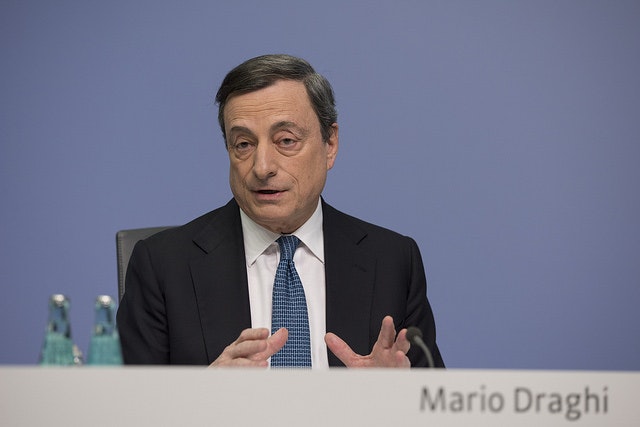The ECB increases QE, but Leaves Door Open for Helicopter Money

Following a series of new measures to boost inflation in the Eurozone, the president of the European Central Bank said helicopter money – a form of QE for People – had not been studied by the ECB so far, but finds the concept is ‘very interesting’.
Yesterday, in Frankfurt, the ECB’s governing council held its monetary policy meeting. As expected the ECB announced a new series of measures including interest rate cuts, more long term lendings to banks, and more notably an increase of the current Quantitative Easing (QE) programme from 60bn to 80bn per month.
More of the same
As we have been arguing since the beginning of the campaign, we believe QE is failing regardless of the volume of the programme. Instead, we think, QE should completely bypass the financial sector and reach the real economy directly. The ECB could create new money to finance:
• New lending directly to the real economy (i.e. via the European Investment Bank),
• Direct cash transfers to households, such as a one-off “citizen’s dividend” or tax cut,
• Government expenditure on infrastructure.
Despite a few minor changes in the composition of the asset purchases, we expect the next phase of the QE programme to fail, just like QE has been failing since it started.
However, on a more positive note, Mario Draghi had some interesting comments during the press conference following the ECB’s governing council meeting.
Replying to a German journalist’s question on whether helicopter money was part of the ECB’s toolkit, Draghi said (our emphasis):
“I must say we have not really thought or discussed helicopter money. It is a very interesting concept which has now been discussed by academic economists and in various other environments. But we haven’t really studied yet the concept. [at first sight], it clearly involves complexities both accounting-wise, and legal wise for our view. But of course this term ‘helicopter money’ may mean many different things.”
Draghi’s comment triggered a cascade of responses on twitter, enforcing the momentum around this concept. It is not the first time that Draghi has expressed himself on this topic. Thus far, he has been asked at least 3 times by Members of the European Parliament (see here, here and here) whether he thinks helicopter money or direct money creation would be a more efficient approach.
His newest statement is aligned with the previous ones, but it is probably the first time that officials of the ECB openly mention this topic under so much media scrutiny.
The ECB is late and potentially unprepared
On the one hand, it is worrying that the ECB has not taken the time to scrutinise QE for People in more detail – one would think that, given the situation facing the Eurozone’s economy, all policy options would be explored. This is also particularly worrying as it means that the ECB will be late and potentially unprepared in case a new crisis unfolds, as the Bank for International Settlements fears.
On the other hand, it is reassuring that the ECB has not ruled out this option. If the President is sincere about his interest in this concept, he has no excuse but to seriously consider QE for People as a policy option. The ECB must now catch up and put significant resources into examining the economic effects and implications of QE for People in its various forms.